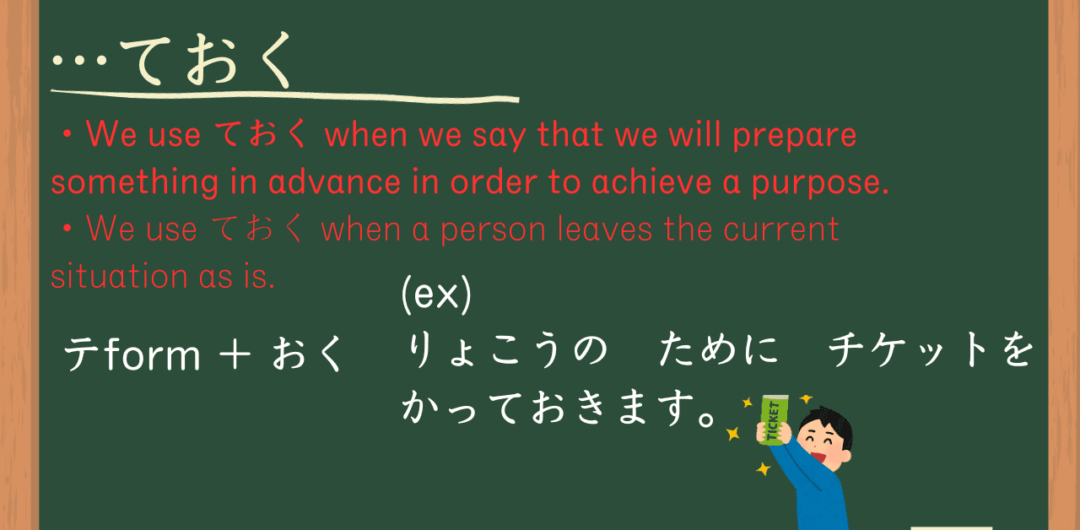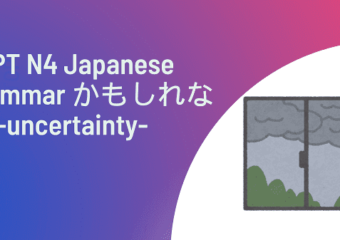When you ask someone to do something in advance, how can you ask it?
You can use ておく for it.
What is ておく and how can you use it?
In this article, I will explain about it.
I have been teaching Japanese for 4 years, so you will understand ておく when you finish reading this article.
There are practice exercises at the end of this article, so please read to the end.
*Are you looking for a place to practice Japanese?
Youtonihongo is for you.
You may receive one free 30-minute trial lesson.

The free trial class online
We offer online classes and in person classes
What is ておく?
ておく has two meaning.
- To do something in advance.
- To leave the current situation as is.
Let’s take a look closer.
To do something in advance
テform + おく (formal)
ておく→とく (casual)
みておきます→みときます
たべておきます→たべときます
If you don’t know what te form is, please read this article first.
Learning Japanese conjugation te form
We use ておく when we say that we will prepare something in advance in order to achieve a purpose.
We also use ておく for preparation for the next time.
Let’s see some examples.
Japanese:
りょこうの ために チケットを かっておきます。
English:
I’ll buy a ticket for a trip.
In this case, he will buy a ticket for a trip in advance.
Buying a ticket is preparation for the trip, so it says かっておきます.
Japanese:
しょくじが おわったら、おさらを あらっておきます。
English:
I’ll wash the dishes after I eat.
In this case, he will wash the dishes so that someone can use them next time.
It is kind of preparation, so it says あらっておきます.
To leave the current situation as is
テform + おく (formal)
ておく→とく (casual)
We use ておく when a person leaves the current situation as is.
Let’s see some examples.
Japanese:
Aさん: おさらをあらっておきましょうか。
Bさん: いいえ、おいておいてください。
English:
Aさん: Shall I wash the dishes?
Bさん: No, please stay here.
Aさん uses おきます because washing is preparation for next time.
Bさん uses おきます because he wants Aさん to stay the dishes (on the table).
Like this example, ておきます means leaving as well as preparation.
Let’s see another example.
Japanese:
まどを あけておいて ください。
English:
Please keep the window open.
He wants to leave the current situation (windows open), so he says あけておきます.
*Please keep in mind that you can’t use ておく for other’s action.
You can’t say that あなたがごはんをたべておきます.
Conclusion

テform + おく
- To do something in advance.
- To leave the current situation as is.
Excercise
1.さきに(たべます→ )おいてください。
2.さきに(いきます→ )おいてください。
3.エアコンを(つけます→ )おきます。
4.ケーキを(かいます→ )おきます。
5.きょうかしょを(よみます→ )おいてください。
Answer
1.さきに(たべます→たべて)おいてください。
2.さきに(いきます→いって)おいてください。
3.エアコンを(つけます→つけて)おきます。
4.ケーキを(かいます→かって)おきます。
5.きょうかしょを(よみます→よんで)おいてください。
If you have questions about this exercise, please contact me or leave a comment below.
If you’d like to learn more Japanese, please feel free to contact me.
I teach Japanese in-person or online.
↓Please feel free to contact me.

The free trial class online
We offer online classes and in person classes



